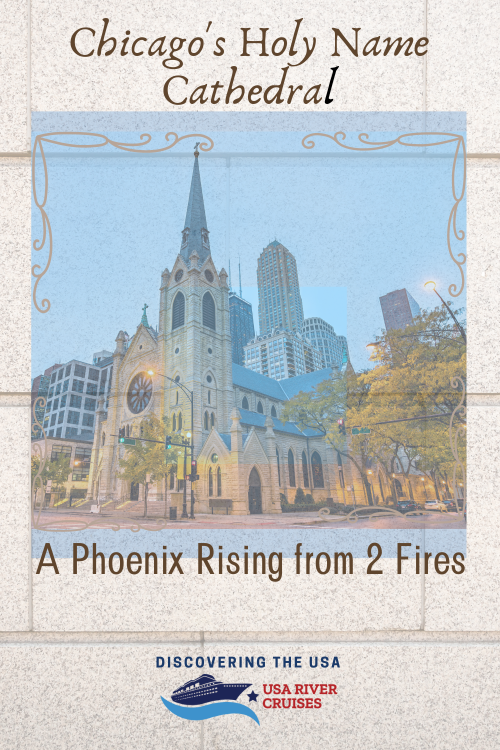
A Phoenix Rising from Two Fires
Chicago, Illinois
By Dawn Woolcott
Beautiful churches, cathedrals, and chapels are not hard to find. Each has its own personality and usually consists of a style accumulated over decades, if not centuries. In every city I travel to, I enjoy visiting a local church to admire the architecture, the craftsmanship, the history, and especially the stained glass. During a busy day of sightseeing, I also enjoy the peace and calm found inside. When you take the time to find out more, you might just find out a fascinating story associated with the building. The Holy Name Cathedral in Chicago has just such a story.
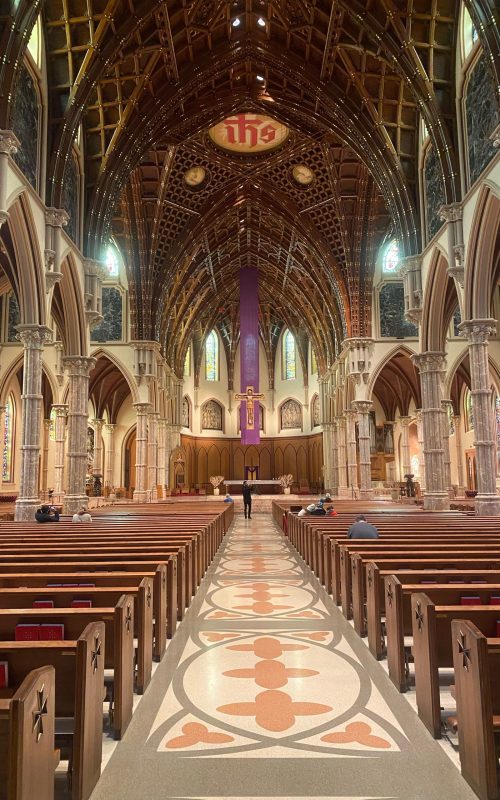
Surrounded by tall skyscrapers, this small cathedral did not always look quite so small. Size is relative, and at the time it was built in 1875, it was a comparatively tall building in the flattened landscape around it. The area of downtown Chicago had just emerged from the Great Fire of 1871 and was slowly being rebuilt.
The parish began as a small chapel founded by Irish immigrants flocking to Chicago, which only had a population of around 22,000 at the time. There was one other Catholic church in the area, but their services were performed in German, and the Irish wanted one in their own language. They located their church just north of the Chicago River and a few blocks west of Lake Michigan.
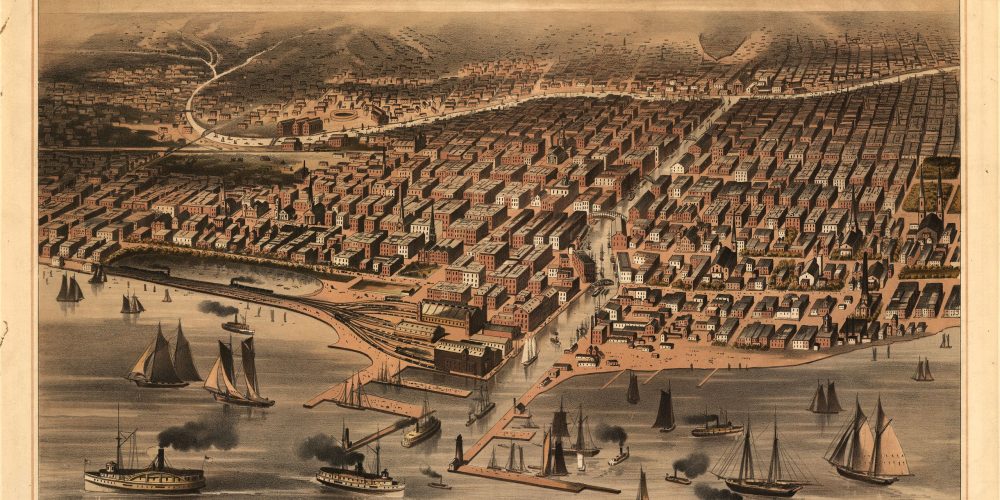
The Great Fire changed everything, destroying about 3.3 square miles and over 17,000 structures right in the heart of downtown Chicago. By this time, the population of the city had grown to around 320,000. The fire engulfed the core of the city quickly, hopping over two branches of the Chicago River to consume the mostly wooden buildings.
Chaos and confusion reigned as residents and workers fled the area at a time when the main source of transport was by horse. It didn’t help matters that most of the sidewalks and even some of the roads were paved with wood. Many of the nearby riverbanks were also lined with lumber yards, coal yards, and warehouses – all highly combustible. Some would say it was an accident waiting to happen. The devastation left in its wake did offer a chance for the city to rebuild – better, safer, and bigger. If ever there was a time for a phoenix to rise from the ashes, this was the time.
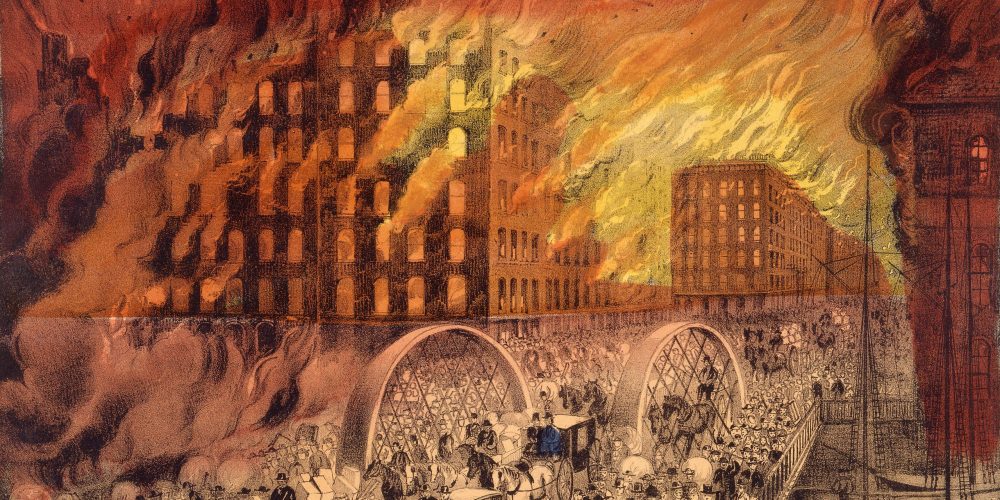
It took several years, and after having to worship in what they called a “shanty cathedral,” the Catholic church began work on rebuilding. The cathedral began construction in 1875, replacing the Cathedral of St. Mary and the Church of the Holy Name which had both been destroyed in the fire. In their place, they built a 210’ spired cathedral, just 16 feet shy of the Notre Dame Cathedral in Paris. Planning for the future, the new cathedral would eventually be large enough to hold 1,500 people.
Over the decades, the cathedral building has undergone substantial renovations as most do, but in an unusual way. It wasn’t adding exterior supports, or whitewashing walls. There was one thing it was lacking – a basement. When in need of expansion, it can be especially difficult to add an extra story onto a cathedral. When extra space was needed, digging down seemed to be the best answer. In 1968, the entire floor was dug up to add basement space which now contains the modern needs of indoor plumbing and electrical, as well as storage.
While visiting you may not see the basement, but you will be enchanted by the interior spaces. You’ll begin with massive brass doors at the entrance and a vestibule screen with a lovely “tree of life” motif. As you walk inside, the first thing that strikes you is the dark wood ceiling. It is unlike most painted and highly decorated ceilings you might see in Europe. In the center of the ceiling are ceremonial red hats hanging down, along with 5 circles surrounding a large center circle with the letters “I H S “. This is an art piece designed by a local artist, Larry Cope, and based on a 15th century design for the holy name of Jesus and with the image of a phoenix rising from the dead behind the letters. Perfectly appropriate for this church.
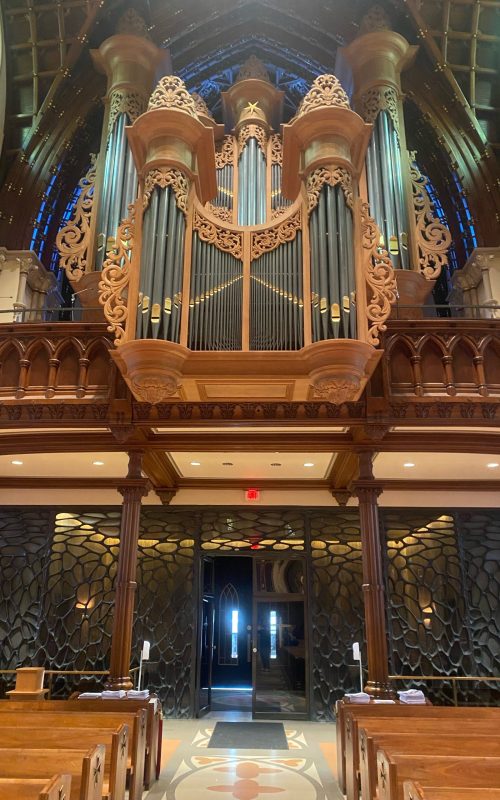
The second design element that strikes you is the massive pipe organ. The organ was built in Holland and made its home in Chicago in the 1980s. Made of hand carved French oak, it’s a piece of art in its own right. The stained glass windows come from Milan, Italy and are all designed to take advantage of the limited light afforded by a church that has become surrounded by tall buildings. The art in them contains abstract illustrations rather than religious scenes, in harmony with the other modern elements found throughout the interior. Art pieces and sculptures all contain a modern feel with sculptures made of brass that are in contrast to the very traditional exterior. Even the pews look modern with their gracefully curved backs which look to be carved from a single piece of wood with not a joint to be seen. .
A phoenix is an appropriate symbol for the Holy Name Cathedral. In February 2009 fire struck once again. Repairs were being made to the ceiling, which had been showing signs of problems since 2008. Repairs were just being completed when a fire broke out in the attic space. Eventually traced to a faulty ice-melting system in the roof, the fire caused extensive water damage inside. After five months of restoration, the cathedral once again rose from the ashes to open its doors to the public.
The Holy Name Cathedral is a treasure to explore when you are in Chicago. You can find it in the heart of downtown, just off the Magnificent Mile near Chicago Ave. and State St. Little treasures like this are one of the joys of traveling and exploring beyond the “top 10 must-see” lists you’ll find in every travel guide. Step inside and take time to feel the quiet, and learn the history.
Learn more about the Holy Name Cathedral
Visit the Holy Name Cathedral and see more of Chicago on one of these cruises to the Great Lakes:
Save this story to Pinterest for future travel reference:
